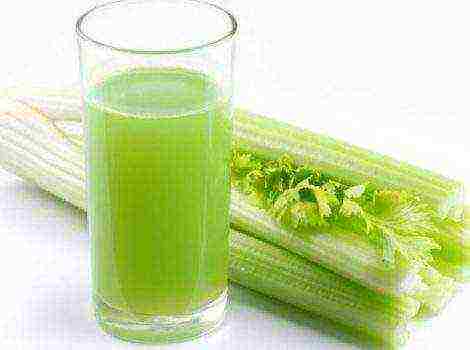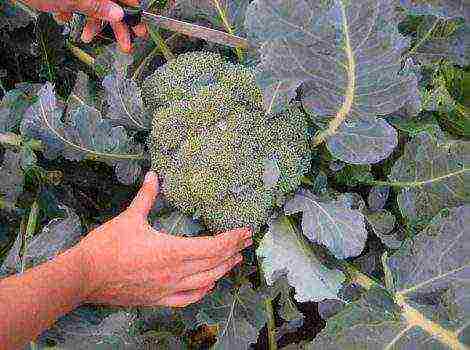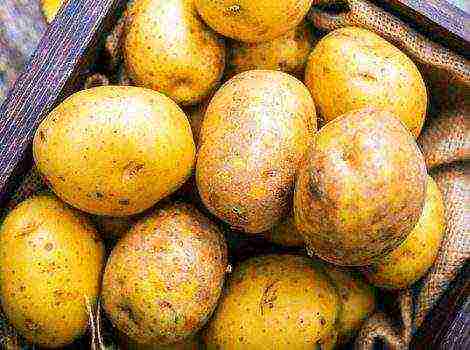Content
Cranberries are the absolute leader in the content of nutrients, vitamins and minerals. It is possible to grow the northern "vitamin bomb" not only in swampy areas, but also in the country. To do this, you need to know the suitable varieties.
Cranberry is a very valuable medicinal plant. Its fruits contain up to 4% of simple sugars (in the form of glucose and fructose) and about 6% of organic acids (mainly citric acid). In small red berries you can find vitamin P, vitamin C, tannins, dyes, phytoncides, pectins, minerals: calcium, potassium, iron, iodine, copper, silver, manganese, phosphorus. Because of such an impressive list of nutrients, cranberries are called "northern lemon" and are credited with truly miraculous properties. Today we will tell you about the varieties of garden cranberries, which can be grown on a personal plot without buying a berry harvested in the swamps.
Scarlet reserved
Bred from wild varieties of the Vologda region of late ripening. A frost-resistant variety that can withstand temperatures down to -33 ° C under snow. The bush is medium-sized, with medium-sized leaves, covered with large berries. Their shape can be different - from round-oval to flat-round, the surface is slightly ribbed. The berry has a very familiar taste - sweet and sour, and it contains up to 17 mg of vitamin C.
| Appointment |
Bush height (cm) |
Berry weight (g) | Ripening period |
Yield (kg / sq.m) |
|
|
13-17 |
0,5-0,8 |
Second decade of September |
1-1,5 |
||
The beauty of the north
This variety was bred from wild forms found in the Karelian Republic. Belongs to varieties of late ripening, very resistant to prolonged and severe frosts (down to -35 ° C). The bush is medium-sized, covered with large berries. The cranberry is covered with a dark red skin with spots, and its taste is closer to sour, without a strong aroma. The plant is slightly affected by snow mold and generally has practically no flaws.
| Appointment |
Bush height (cm) |
Berry weight (g) | Ripening period |
Yield (kg / sq.m) |
|
|
15-17 |
3-5 |
First decade of September |
1,5-3,5 |
||
Red star (Red star)
"Krasnaya Zvezda" may well become a decoration of your site - after all, this is the best variety of European and world selection. Gardeners appreciate it for its excellent annual yields and adaptability to all weather conditions. The bushes can withstand temperatures as low as -30 ° C, and their sprawling shape serves as a decoration for alpine slides and ponds. The berries are large, up to 2 cm in diameter, dark red, with a waxy coating, sweet and sour. Choose a sunny place for planting, but do not forget to shade from the bright spring sun.
| Appointment |
Bush height (cm) |
Berry weight (g) | Ripening period |
Yield (kg / sq.m) |
|
|
15-20 |
1-1,2 |
End of September |
1,5-2 |
||
Stevens (Stevens)
It is one of the largest-fruited varieties with incredible yields. The bush is vigorous, forms powerful, tall, vertically directed shoots. The berries are very large, rounded-oblong, dark red with a matte bloom. The pulp is juicy and firm, with a strong sweet and sour taste. The variety is frost-resistant and slightly susceptible to disease. The plant reaches its peak fruiting at 3-4 years old, and by that time gardeners begin to call it nothing more than a "fruitful record holder".
| Appointment |
Bush height (cm) |
Berry weight (g) | Ripening period |
Yield (kg / sq.m) |
|
|
15-20 |
2,5-3 |
End of September - beginning of October |
2,5-3 |
||
Wilcox (Wilcox)
This variety is indispensable for anyone who is on a diet or needs nutritional therapy.The plant feels great in peat areas and is characterized by increased frost resistance. Shoots grow quickly and soon form a compact crown. The berries are bright red, oval-oblong, of medium size. They are well stored and are recommended for fresh, frozen use, as well as for preservation.
| Appointment |
Bush height (cm) |
Berry weight (g) | Ripening period |
Yield (kg / sq.m) |
|
|
16-18 |
1,5-2 |
Mid september |
1,5-2 |
||
Franklin
Erect bushes of this variety cannot be overlooked on the site. They are distinguished by the rapid growth of shoots (9-10 cm per year) and the weak formation of short, creeping processes. The berries are oblong, sometimes oval, dark red. They can be stored without spoilage all winter, and are also suitable for any kind of processing and fresh consumption. The variety is especially resistant to the false flowering disease.
| Appointment |
Bush height (cm) |
Berry weight (g) | Ripening period |
Yield (kg / sq.m) |
|
|
18-25 |
1-1,3 |
Mid september |
2-2,5 |
||
By planting cranberries in your area, you will always have a supply of vitamins and minerals necessary for health. This is a truly unique plant that has no analogues in the world and, which is doubly pleasant, is quite resistant to frost and diseases. Start growing cranberries and you won't be disappointed.
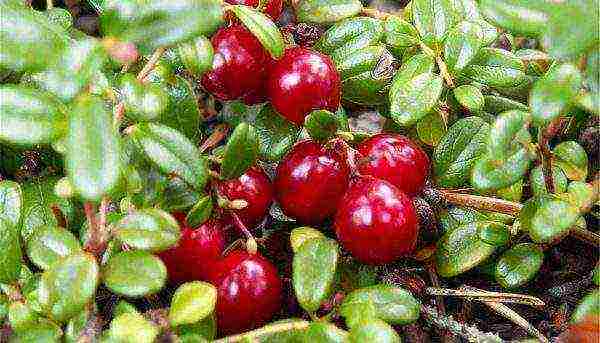
When choosing planting material, the main directions are winter-hardy and large-fruited varieties of cranberries. The yield of the bush largely depends on the correctly selected variety, taking into account the climatic characteristics.
Cranberries are distributed almost throughout Russia, in Europe, North America and Canada. Under natural conditions, it grows in humid places: swamps, lowlands or mountainous areas with fertile soil. Marsh cranberry is the most winter-hardy in comparison with other varieties. The first cultivated representatives of this plant appeared only in the twentieth century. Earlier attempts to grow cranberry bushes were unsuccessful, since the plant, cut off from its usual habitat, ceased to bear fruit and died.
Representatives of marsh cranberries with good winter hardiness are:
- Scarlet reserved. High-yielding variety with large globular berries. The fruits ripen in early September and reach a mass of 2 g.
- Beauty of the North. High-yielding late ripening variety. The fruits are very large - up to 4.5 g. The oval-shaped berries have a red-crimson hue.
- Severyanka. The variety is characterized by large oval berries up to 3 g. Waxy bloom predominates on dark red berries. The yield of the variety is good. The fruits ripen at the end of August.
- Gift of Kostroma. A large-fruited variety with an average yield. The fruits ripen at the end of August. The berries are large, rounded, ribbed. The berries are well preserved.
Large-fruited cranberry varieties include:
- Ben Lear. Early ripening variety. Fruits are large, red-pink in color, intended mainly for processing.
- Searles. American variety with good frost resistance. The berries are well stored and can be transported well.
- Stevens. High yield variety with dark red berries. The fruits ripen at the end of September and have a long shelf life.
Antipyretic properties of cranberries
The antipyretic properties of cranberries are possible due to the content of acetylsalicylic acid in fruits. It is she who is aspirin and helps to reduce temperature. For medicinal purposes, cranberries are used in their pure form or as drinks or jam. Berries can be used both for the prevention of colds and for their treatment.
The consumption rate of cranberries is a tablespoon three times a day. You should not gorge on cranberries, since the acid it contains in large quantities can negatively affect the stomach and intestines.
It must be remembered that there can be many reasons for increased body temperature.If the fever is observed with colds and the temperature rise is small, then cranberries are recommended to be used as a medicine.
If the nature of the rise in temperature is unknown or it is too high, it is best to consult a doctor.
back to content ↑ Green cranberries - useful properties
The beneficial properties of green cranberries are fully revealed if the harvest time is observed. Collecting it completely green is not worth it, since the necessary vitamins and minerals have not yet been formed in the required amount. The earliest harvest time is late summer - early autumn. You should not pick cranberries before August 25 - such a berry, most likely, will not ripen.
Early collection of berries allows you to increase the duration of their storage. The collected berries can be used to prepare various dishes. Soaked berries, mashed with sugar or frozen, are well stored. After any processing, cranberries almost do not lose their beneficial properties.
Cranberries are used as a febrifuge for colds. In addition, they perfectly strengthen the immune system and help with diseases of the oral cavity.
Cranberry is indispensable for the gastrointestinal tract, as it improves digestion, normalizes microflora and contributes to weight loss and normalization of metabolism.
Cranberry is indicated for diseases of the lungs, liver and kidneys, as well as for the prevention of diseases of the cardiovascular system.
Cranberry regulates the emotional state, improves the nervous system and promotes a good night's rest.
back to contents ↑ How to plant cranberries in the garden
Most gardeners grow cranberries solely for their usefulness and medicinal properties. In order to find out how to plant cranberries in the garden, you need to figure out what conditions this berry loves and what should not be on the site.
First you need to decide on the landing site. It is good if it will be located near water bodies or artificial ponds. This will create increased humidity and a suitable microclimate for this plant. The proximity to the soil surface of groundwater is also an additional source of nutrition. Ideally, groundwater should not be below 50 cm, otherwise more frequent watering of cranberries will be required.
In some cases, it is permissible to create small ponds specifically for growing nearby cranberries. Cranberries get used to the chosen place, so it is not recommended to replant them.
The soil for growing cranberries should be peaty, fertile and acidic. The peat mixes with the sand and covers the soil at the site. Some soil can be taken from the area where cranberries grow naturally.
In the case of sandy and sandy loam soils, it is necessary to add about 20 buckets of peat to each seat and dig it up. Cranberries can be grown in horizontal trenches up to 150 cm wide and up to 35 cm deep. The trench is filled with a mixture of peat and sand, watered and planted with 2 seedlings for each planting place. This method works well for young shoots about 12 cm long.
Cranberries prefer acidic soils with a pH of 3.5 to 5.5. To do this, the beds are covered with a 20 cm layer of sour peat, and the upper part with sand. The site is loosened, weeds are removed and cranberries are planted. Planting can be done both in spring and autumn. Young seedlings are carefully placed in 15x15 cm planting holes so that no more than 4 cm remains on the surface. The distance between the holes should be about 20 cm. Next, the soil must be mulched with sand or needles and water the plants.
Important: It is necessary to ensure that the soil always remains moist, since the yield depends on the amount of moisture.
Cranberries should not be planted in close proximity to potatoes, cabbage, tomatoes and other nightshades - the composition of their soil is radically different. Cranberries love the neighborhood with conifers, as well as lingonberries.
back to content ↑ Canadian cranberries - cultivation
The cultivation of Canadian cranberries allows you to obtain valuable berries with high taste characteristics, distinguished by their large size and universal use.
The most productive varieties of Canadian cranberries:
- Ben Lear. Shrub of medium height with large maroon berries. The berries ripen in early September, but storage is short-lived. Fruit weight no more than 2 g.
- Stevens. An early ripe variety with large oval-shaped berries. The yield of the variety is good.
- Wilcox. A frost-resistant variety that ripens in mid-September. The berries are oval, bright red, of medium size.
- Pilgrim. Medium ripening variety, vigorous with numerous shoots. Berries are oval in irregular burgundy color. The yield is good. The variety is frost-resistant.
When growing, it is necessary to create a special microclimate with high humidity for cranberry seedlings. Correct observance of soil quality will allow the shrub to grow healthy and bear fruit well. Watering the plants plays an important role. It should be done regularly, wetting the entire root system to a depth of about 40 cm from the soil surface.
Cranberries need weeding and fertilizing with mineral fertilizers. Young seedlings need to be fed twice a season to stimulate their growth. In the autumn, it is necessary to carry out preventive treatment against diseases and pests.
Pruning can be done to form bushes. By pruning the horizontal branches, you will get a more compact shrub, from which it is more convenient to harvest. Pruning vertical branches will reduce the height of the shrub, allowing the creeping branches to spread freely on the ground.
Tip: It is best to prune young plants. The shrub reacts poorly to pruning after 4 years.
It is best to purchase cranberry seedlings from a nursery. So you get high-quality material that will easily take root on the site. Resistance to frost and disease, as well as yield, will no longer be a surprise. A healthy plant will produce quality fruit at no extra cost.
A good cranberry variety is half the battle. What variety of large-fruited cranberries to choose to pick berries on your site? I offer you several varieties of domestic and foreign selection, divided into groups according to maturity.
Cranberry varieties of domestic selection
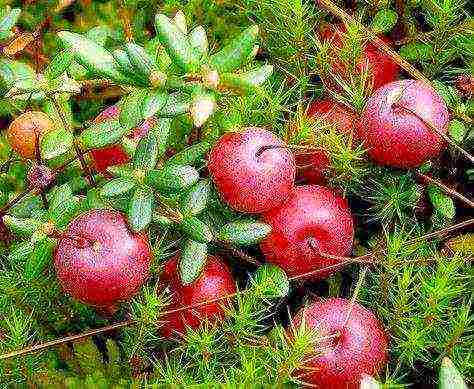
Mid-season cranberry varieties:
Gift of Kostroma - the berries of this variety are the largest, with an average weight (1.9 g), sour without aroma. Are not damaged by pests.
Sazonovskaya a variety of cranberries with medium-weight berries (0.7 g) of a round-flattened shape. The berries are slightly ribbed, sweet and sour.
Severyanka - a variety of cranberries with very large red berries (1.1 g). Frost resistance is high.
Sominskaya - a variety of cranberries with a large berry (0.93 g), lemon-shaped red. the variety is frost-resistant. It is affected by "snow mold".
Khotavitskaya - red and dark red rounded berries of this cranberry variety of medium and large size (0.86 g). The taste is sour, no aroma. The advantages of the variety are frost resistance. It is affected by "snow mold".
Late-ripening cranberries
Scarlet reserved - the bush is weak, the berries are large (0.8 g). Winter hardiness is high.
The beauty of the north - the berries of this variety of cranberries are large and very large (1.5 g), rounded-oval, pink, sour taste.
Cranberry varieties of foreign selection
Early ripe cranberry varieties:
Ben Lear (Ben Lear) is a cranberry variety with large rounded berries (diameter 18-20 mm). Cranberries of this variety ripen in late August-early September, berries are stored for no more than 2 weeks, they are used mainly for processing and freezing. Productivity 1.5-2 kg / sq.m
Black Vale - a variety of cranberries with medium-sized oblong-oval berries (15-18 mm in diameter). The berry ripens in early September and is used both fresh and for processing.
Mid-season cranberry varieties:
Wilcox (Wilcox) - a variety of cranberries with medium-sized berries (up to 20 mm in diameter), oblong-oval, bright red ripen in mid-September, are used fresh and for processing. Productivity - 1.5-2 kg / sq.m.
Franklin (Franklin) is a medium-sized cranberry variety (13-15 mm in diameter). The berries are dark red, ripen in mid-September, do not deteriorate for 3-4 months, the variety is resistant to the false flowering disease. The berries are used fresh and for processing.
Searles - a variety of cranberries with large berries (up to 23 mm long), dark red, without gloss, sometimes with specks, with dense pulp, ripen in mid-September, used fresh and for processing. The keeping quality of the variety is satisfactory.
Late-ripening cranberries:
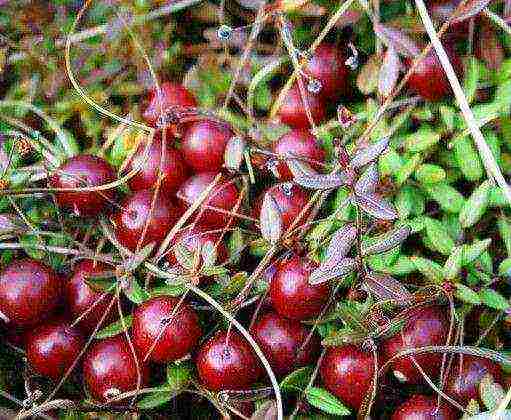
Stevens (Stivens) - berries of this variety are large, round-oval (22-24 mm in diameter), dark red, dense, very well stored (up to 1 year), ripen at the end of September, are used fresh and for processing. This is one of the best varieties of large-fruited cranberries. The yield of the variety is 2-2.5 kg / sq.m.
McFarlin (Mc. Farlin) - cranberries of this variety are round-oval, dark red, with a dense waxy bloom and firm pulp, excellent taste, ripen in late September-early October, well stored, used fresh and processed. The yield of the variety is 1.5-2 kg / sq.m.
Pilgrim (Pilligrim). The berries of this cranberry variety ripen in early October. The variety is distinguished by good growth, powerful development of creeping shoots. Large, oval-shaped, purple-red berries with an uneven color and a yellowish waxy bloom have a satisfactory keeping quality.
